Client
This option of the Main Menu Bar is dedicated to your customers performance in terms of traffic volume, income and profit.
The levels of detail of this functionality are represented in figure 4.
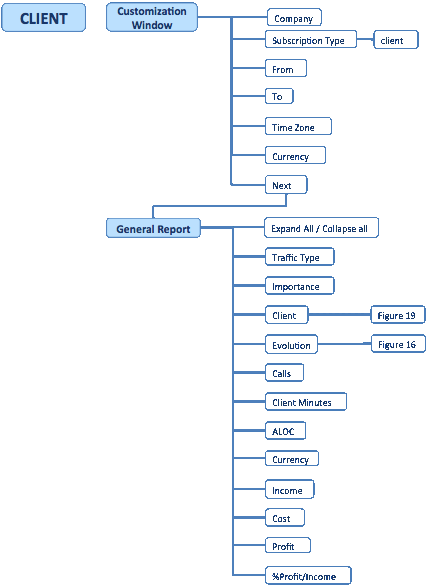
Following is a description of the tables and windows in the option âClientâ of the Main Menu Bar.
Note: You can customize any table of BILLING by clicking on the right corner of any cell. This action will display the following window:

Click on âColumnsâ to display the list of parameters and check mark on those you want to see on the table.
Customization Fields
Figure 6 shows the customization fields that are used to generate a report that reflects your specific needs of information. By default, the BILLING module will display the performance of all the group of companies for the prior day.
⢠Company This field is used when different companies, business units or subsidiaries carry on your business. You can see the performance of the entire group or select the company/business unit of your interest.
⢠Subscription Type With this field you can select between client (incoming traffic) and provider (outgoing traffic). The data will load accordingly. This field is an alternate way to go to Client and Provider in the Main Menu Bar.
⢠From - To You can customize your search by date using these fields. The commands < and > are used to move your search one day back or forth separately. With these commands, you can define a timeframe of more than one day. The commands << and >> are used to move the complete time frame back and forth. For example using < and > you can define a timeframe of three days like this: From 2012-12-07, To 2012-12-09. Using << you move the same timeframe, three days back: From 2012-12-04, To 2012-12-06. Using >> you move the same timeframe, three days forth: From 2012-12-10, To 2012-12-12.
⢠Time Zone There are three options in this field. Internal time refers to the time set as a reference by your organization, usually UTC. Client time refers to the time specified by the customer as a reference for billing purposes. Provider time refers to the time specified by the provider as a reference for billing purposes.
⢠Currency By default, the currency used for the Cost and to calculate the Income, Profit, % Profit / Income, and % Profit / Cost, is USD. If you switch to EUR, you will see these values calculated in Euros, according to the reference values of the window located in the top right corner (Figure 7).

Click on to get detailed information of the currency exchange rates used for the prior week (figure 8).
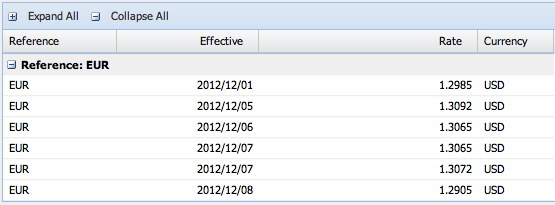
⢠Next your customized report will be displayed with this command. Figure 9 is an example of the data displayed by default.

General Report
The Client General Report is a complete summary of your customerâs performance. Following is a description of the fields.
Note: Most of the tables in BILLING can be exported using various formats: CSV, Excel, Xml.
Expand All / Collapse All
The table data is divided by traffic type. Use ![]() to see details by customer or
to see details by customer or ![]() to see just the subtotals.
to see just the subtotals.
Traffic Type
The data is organized by traffic type -access, direct, hubbing, etc. Use ![]() or
or ![]() to expand or collapse data for a specific traffic type. The type of traffic can be defined when the account is configured in the BILLING module.
to expand or collapse data for a specific traffic type. The type of traffic can be defined when the account is configured in the BILLING module.
Importance
To determine the importance of a customer (or Provider), the system performs an algorithm based on the daily billing and the historical profit of the previous 30 days. The algorithm takes into account the profit, the turnover and the margin for each destination of this account with respect of other accounts.
Client is the carrier that is sending traffic to your network. Figure 10 shows the levels of detail of this option for a specific customer.
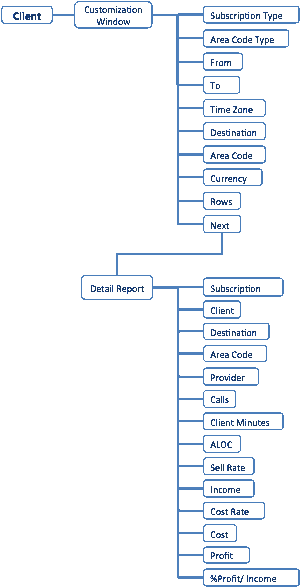
Click on a client of the General Report to see detailed information about the traffic. Figure 11 is an example for customer Algerie Tel.
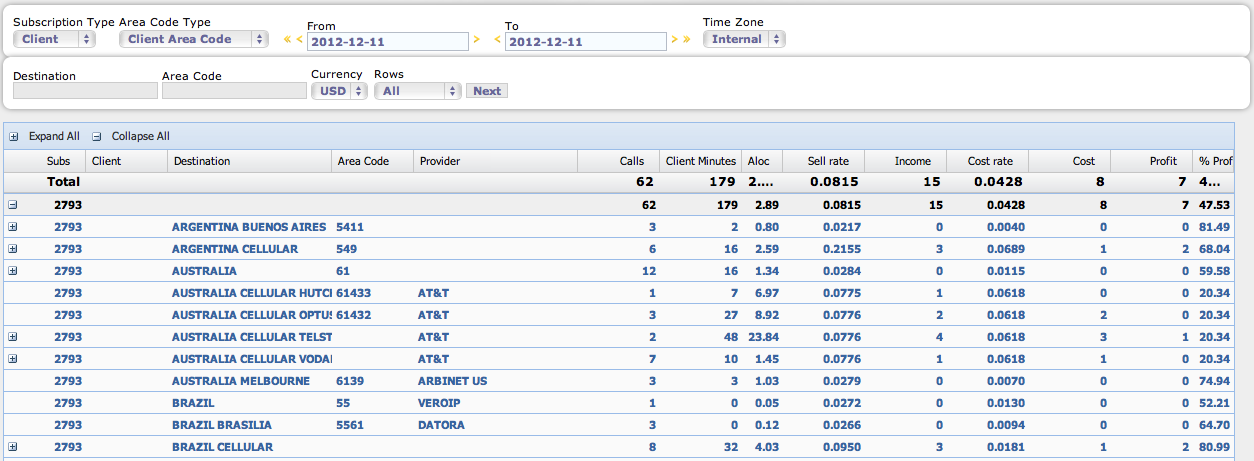

In the first part of this screen you can find the following fields to customize your Client Detail Report:
⢠Subscription Type Since you are in the option âClientâ of the Main Menu Bar, this option will show by default, Client. You can switch to Provider if you want to see the list of carriers that terminate the traffic that this customer is sending.
⢠Area Code Type For your customer certain destination comprises codes that you might define as a separate destination. To clarify this aspect, you have three options in the Area code Type: Client Area Code is used to present the traffic according to your customerâs definition of destinations. Provider Area Code is used to see the traffic according to your providerâs definition of destinations, and the Internal Area Code is used to present the traffic according to the codes defined per destination by your organization.
⢠From â To You can customize your search by date using these fields.
⢠Time Zone As previously described.
⢠Destination You can include the destination of the traffic in your customization.
⢠Area Code You can customize the clientâs report by including a specific area code where your customer sends traffic.
⢠Currency This field allows you to choose the currency you want the data to be displayed.
⢠Rows You can select the amount of files you want to see in the screen: 50, 100 or all.
⢠Next Your customized search will be displayed with this command.
The client detail report contains the following fields:
⢠Expand All / Collapse All
⢠Subscription A carrier can have two different types of subscriptions: one as provider and one as client. The subscription defines each of the products which you have a relationship with your customer or supplier. For example, if you sell a carrier one product âgoldâ and one product âsilverâ, each product would have a subscription.
⢠Client If, for example, you retrieve information of a retail customer, this field will show the name of the product (calling card).
⢠Destination Destination refers to the network where the call is intended to terminate.
⢠Area Code This column will show the area code according to your requirements in the customization fields âArea Code Typeâ, and âArea Code.â
⢠Provider This is the carrier that is terminating your customerâs traffic.
⢠Calls These are the connected calls that this customer sent for you to terminate in the destinations.
⢠Client Minutes This refers to the total minutes per call to be billed. The contract specifies the way your customerâs calls should be billed in terms of incremental intervals.
When you export the client report, you will also see the Providers Minutes which refer to the amount of minutes measured depending on your providerâs methods of billing (incremental intervals). You also have the Internal Minutes, which refers to your methods of billing in terms of minute rounding.
⢠ALOC Average Length of Call.
⢠Sell Rate The rate that is specified in the contract.
⢠Income The Sell Rate multiplied by the Client Minutes.
⢠Cost Rate The rate per minute that the terminating carrier charges.
⢠Cost The Cost Rate multiplied by the Provider Minutes.
⢠Profit This is the Income minus the Cost.
⢠% Profit / Income This is your net profit percentage.
When you export the table, you also have the % Profit / Cost which is your profit percentage. The following figure shows that by clicking on one of the clients, you can see the specific activity for the destinations.
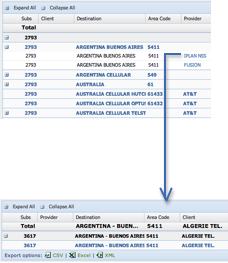
Evolution
Now, going back to Client in the Main Menu Bar, the next column in the General Report is Evolution. Click on and you will load a customizable graph that shows the traffic performance for the customer. Figure 18 shows the topology of this window.
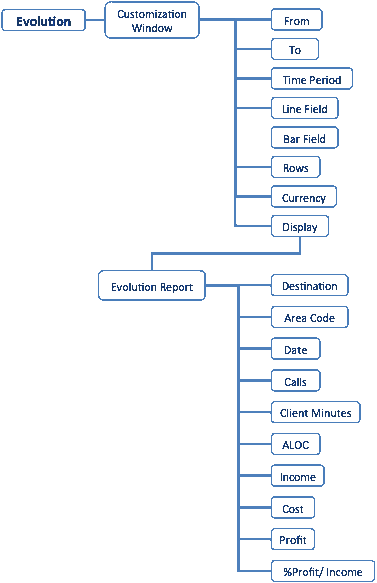
By default, the graph will show a bar chart for the Income, and a line chart for the Profit. Both charts are developed over the last week. The scale for the Income is on the right side of the graph and the scale for the Profit is on the left side of the graph. Hover the cursor over the bars or the line chart to see the exact value (figure 14).

The graph can be customized using the following fields:
⢠From and To The commands < and > will add one day to your graph, either at the beginning or at the end of the time frame. The commands << and >> are used to move the complete time frame back and forth.
⢠Time period You can change the scale of the horizontal axis to Month, Weeks and Days, depending on the length of your time frame. You can also see the performance of your customerâs traffic for a specific day of the week. For example, if you select Sunday, you will see the bar chart and the line chart for every Sunday in the time frame you specified in the From and To fields.
⢠Line Field With this window you can choose the line chart to represent Calls, Minutes, Income, Cost, Retail Income, or Profit.
⢠Bar Field With this window you can choose the bar chart to represent Calls, Minutes, Income, Cost, Retail Income, or Profit.
⢠Rows By default the Evolution window will show all the registers for the last week. You can chose to load only 50 or 100 rows.
⢠Currency This window allows you to choose the currency you want the data to be displayed.
⢠Display Your customized graph will be displayed with this command.
By default, the Evolution window will also show a table with all the registers for the last week (figure 15).

The Clientâs Evolution Report has the following fields: ⢠Destination This is a customizable field that shows the destination of your customerâs traffic. By default it will show the complete list of all the destinations that your client is sending traffic.
⢠Area Code This is a customizable field that determines the area code of your customerâs calls.
⢠Date This field is determined by the To and From fields.
⢠Calls The amount of connected calls to the specific destination, area code, and date.
⢠Client Minutes This is the total amount of minutes for the specific destination, area code and date. These minutes are measured according to the contractual specifications.
⢠Aloc This is the Average Length of Call.
⢠Cost The cost per minute is specified in the contract.
⢠Profit This is the daily profit for the specific destination.
⢠%Prof / Income This is your daily net profit percentage for the specific destination.
Calls
Now, going back to Client in the Main Menu Bar, the next column in the General Report is Calls. The first row right after the header contains the total values for each measurable column. The column calls represents the connected calls that the customer sent to your network to direct it to the destinations.
Client Minutes
As previously described.
ALOC
This is the Average Length of Call.
Currency
This column shows the contractual currency used for billing purposes.
Income
As previously described.
Cost
As previously described.
Profit
As previously described.
% Profit / Income
As previously described.